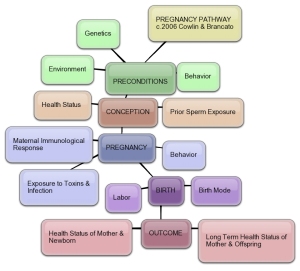Pregnancy Pathway, Pregnancy — Behavior: Avoiding Risks
Sometimes it seems like pregnancy is a time of restrictions. Avoiding risks can be one thing that makes it seem that way. But, bear with us here in an interesting trip through danger and finding you find ways of enhancing your pregnancy!
Risk Factor #1:
Lack of prenatal care. More than anything else, be sure you have care. Having someone monitor your health and that of your baby during pregnancy is vital to a good outcome.
Risk Factor #2:
Not exercising. Sedentary behavior increases the risk for metabolic, cardiovascular and immune disorders.
I know, I know, you don’t have time to exercise. Well, pay now or pay later, as they say. Make time to go to a class (make sure it includes 20 ‑30 minutes of aerobics) a couple times a week. A class will also provide social support, another factor that enhances your pregnancy. Take a walk at lunch time. Practice relaxation techniques.
Risk Factor #3:
Breathing dangerous fumes. Yes, this includes smoking and second-hand smoke. But, it also means avoiding environments where there is a lot smog (near highways), living with mold or dust, and fancy cleansers that may have dangerous chemicals in them. Stick with vinegar, ammonia or bleach as cleansers.

Smog can endanger your fetus!
We are learning that combustion exhaust from cars and trucks can negatively affect birth weight and prematurity. If you live or work near a highway or in an area where smog is prevalent, what are your options? Can you transfer or move? Can you wear a mask? Talk to your care provider and figure out the best protection for you and your fetus.
Risk Factor #4:
Poor Nutrition. Yup, just go back one entry and find out how food affects pregnancy. If you don’t eat enough protein and drink enough water, you don’t make sufficient blood volume to nourish your placenta and thus your fetus.

Read labels!
Eat whole foods and learn to read labels when you buy processed foods. What is a “processed” food? Anything with more than one ingredient!
Some processing (ex: homemade soup) takes little nutrition away, but some processing (ex: potato chips) takes everything good away and replaces it with unsafe substances. Look for low sodium, low sugar, high vitamin and mineral content items with no saturated or trans fats.
Read the ingredients; if you don’t know what the words mean, maybe you want to pass it up.
Risk Factor #5:
Alcohol and Drugs. Common items can be as dangerous as street drugs, which

There is plenty of time in life for a glass of wine…later.

No. No. No. Only meds from your prenatal care provider are okay.

Caffeine? Only one cup & only if you must.
can severely compromise you baby’s future. If you have a drug or alcohol habit, get help.
Risk Factor #6:
Genetics. You can have genetic predispositions for many pregnancy issues. However, that does not necessarily mean you will develop a given disorder. For example, nutrition and exercise greatly reduce the risk and severity of metabolic issues. Some genetic issues are unavoidable however, and your care provider will alert you to these, if they are relevant.
Risk Factor #7:
Social issues — isolation, lack of support, abuse, poverty. All of these factors can have negative effects.
If isolation is a simple matter of needing to meet other moms-to-be, join an exercise program. That way, you get both support and exercise; just be sure it includes aerobics, along with centering, relaxation and appropriate strength.
If your situation is more dire, seek the help of a care provider or social worker at your local hospital or clinic. Safety and support are critical for you at this time. Get the help you need. There are people who care. And, if you know of someone who needs help, help them.
If you have other risk factors to offer, please post them in the comments. Thanks!
What’s next? BIRTH!!








